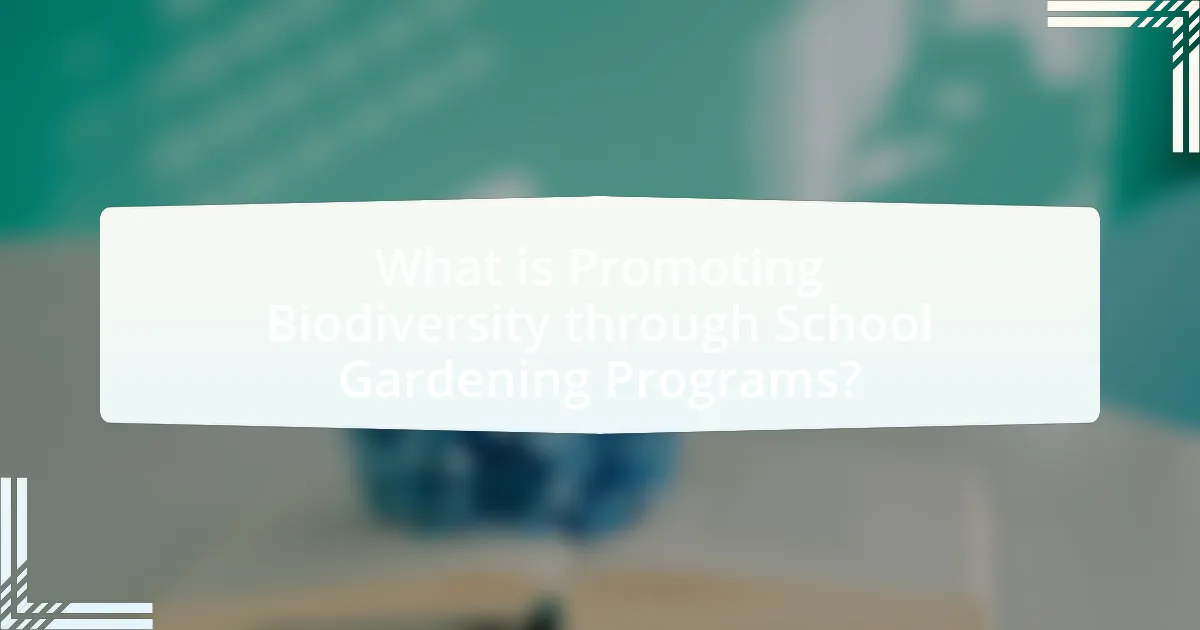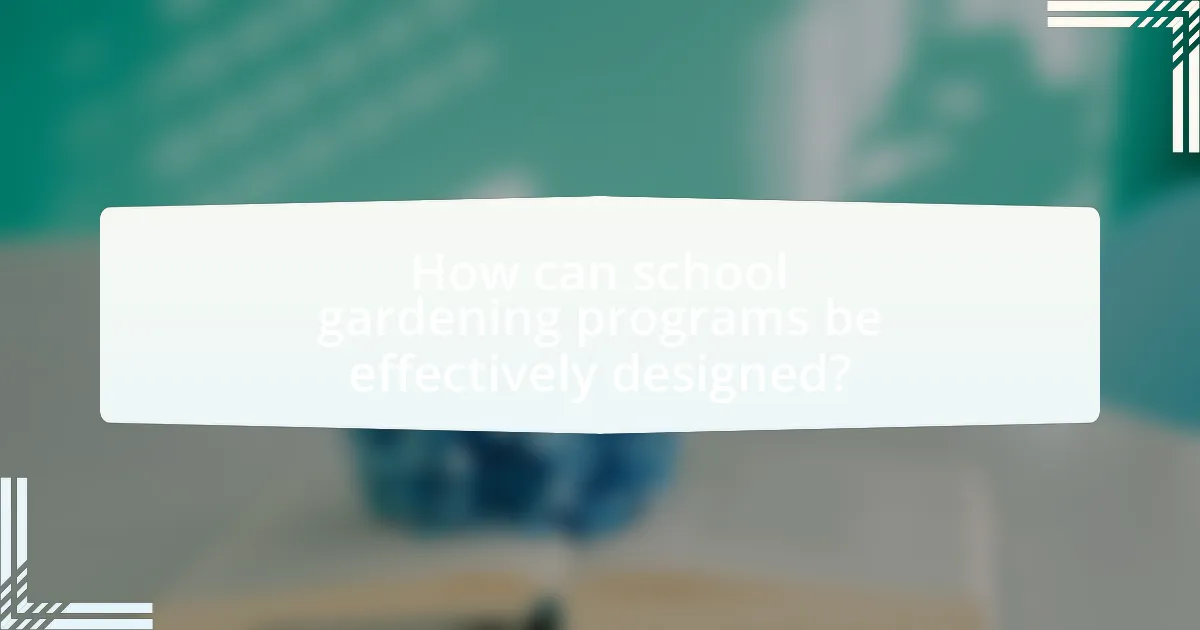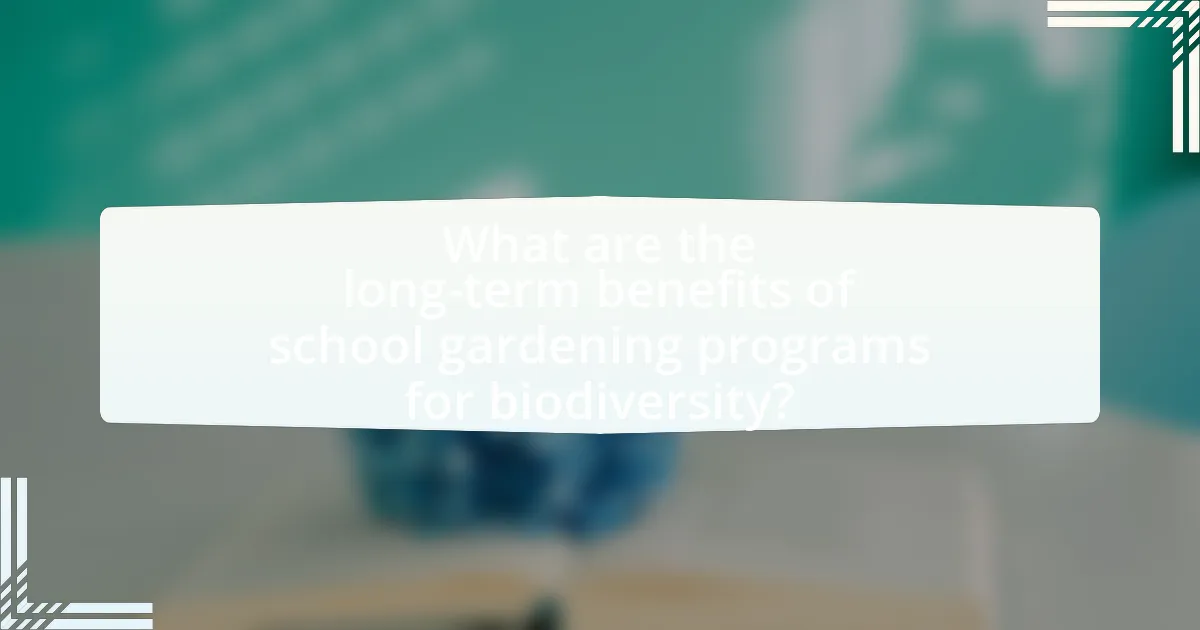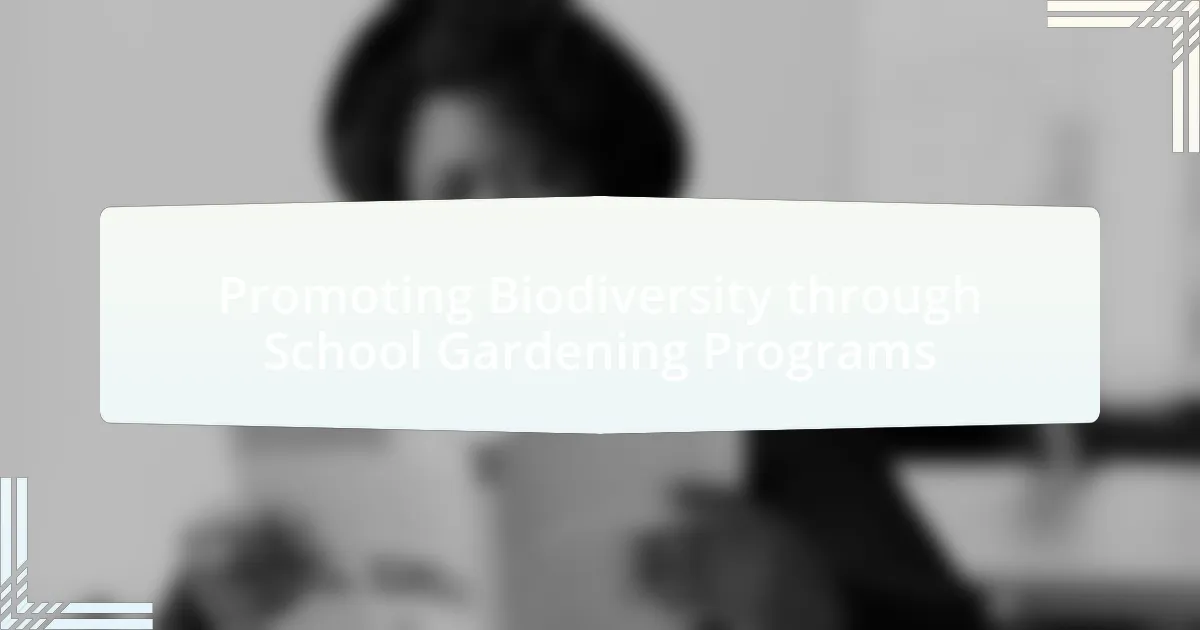Promoting biodiversity through school gardening programs involves the establishment of educational gardens that enhance local ecosystems and support diverse plant and animal species. These programs engage students in hands-on activities that teach ecological principles, emphasizing the importance of native plants and pollinators. Research shows that school gardens can significantly increase local biodiversity by providing habitats and food sources for wildlife, while also fostering environmental stewardship among students. The article explores how these programs contribute to biodiversity, the types of plants used, the challenges schools face in implementation, and the long-term benefits for both students and local ecosystems. Additionally, it discusses effective strategies for designing and maintaining successful gardening initiatives that promote sustainable practices and community involvement.

What is Promoting Biodiversity through School Gardening Programs?
Promoting biodiversity through school gardening programs involves creating educational gardens that enhance local ecosystems and support a variety of plant and animal species. These programs engage students in hands-on activities that foster an understanding of ecological principles, such as the importance of native plants and the role of pollinators. Research indicates that school gardens can increase biodiversity by providing habitats for insects, birds, and other wildlife, while also teaching students about sustainable practices and environmental stewardship. For instance, a study published in the Journal of Environmental Education found that school gardens significantly improved students’ knowledge of biodiversity and their connection to nature.
How do school gardening programs contribute to biodiversity?
School gardening programs contribute to biodiversity by creating habitats for various plant and animal species. These programs often incorporate native plants, which support local ecosystems and promote the survival of pollinators such as bees and butterflies. Research indicates that school gardens can increase local biodiversity by providing food sources and shelter, thereby enhancing the ecological balance within the community. For instance, a study published in the journal “Biodiversity and Conservation” found that urban gardens significantly increased species richness in metropolitan areas, demonstrating the positive impact of such initiatives on local biodiversity.
What types of plants are typically included in school gardens to enhance biodiversity?
School gardens typically include a variety of native plants, pollinator-friendly flowers, vegetables, and herbs to enhance biodiversity. Native plants are crucial as they support local wildlife, including insects and birds, while pollinator-friendly flowers like sunflowers and coneflowers attract bees and butterflies, essential for pollination. Additionally, incorporating vegetables such as tomatoes and peppers, along with herbs like basil and mint, promotes a diverse ecosystem that can sustain various species. Research indicates that gardens with diverse plant types can increase species richness and ecological resilience, making them effective tools for promoting biodiversity in educational settings.
How do these plants support local ecosystems?
These plants support local ecosystems by providing essential habitats and food sources for various species. For instance, native plants attract pollinators such as bees and butterflies, which are crucial for the reproduction of many flowering plants. Additionally, these plants improve soil health by enhancing nutrient cycling and preventing erosion, thereby maintaining ecosystem stability. Research indicates that gardens with diverse plant species can increase local biodiversity by up to 30%, fostering a balanced ecosystem that supports both flora and fauna.
Why is biodiversity important in educational settings?
Biodiversity is important in educational settings because it enhances learning experiences and fosters environmental stewardship among students. Engaging with diverse plant and animal species in school gardening programs allows students to understand ecological relationships, the importance of ecosystems, and the role of biodiversity in sustaining life. Research indicates that hands-on experiences with biodiversity can improve students’ critical thinking and problem-solving skills, as they learn to observe, analyze, and interact with their environment. Furthermore, studies show that exposure to biodiversity in educational contexts can increase students’ awareness of environmental issues, leading to more sustainable behaviors in the future.
What role does biodiversity play in environmental education?
Biodiversity plays a crucial role in environmental education by providing a tangible context for students to understand ecological relationships and the importance of conservation. Through hands-on experiences in school gardening programs, students learn about various species, their interdependencies, and the impact of human activities on ecosystems. Research indicates that engaging with diverse plant and animal life enhances students’ awareness of environmental issues, fostering a sense of stewardship and responsibility towards nature. For instance, studies show that students involved in gardening programs demonstrate increased knowledge of biodiversity and its significance in maintaining ecological balance, which is essential for sustainable living.
How can biodiversity awareness impact student behavior towards nature?
Biodiversity awareness can significantly enhance student behavior towards nature by fostering a sense of responsibility and stewardship. When students understand the importance of diverse ecosystems, they are more likely to engage in conservation efforts and sustainable practices. Research indicates that educational programs focusing on biodiversity, such as school gardening initiatives, lead to increased environmental knowledge and positive attitudes towards nature. For instance, a study published in the Journal of Environmental Education found that students participating in hands-on gardening activities demonstrated improved ecological understanding and a greater commitment to protecting natural habitats. This connection between awareness and behavior underscores the critical role of biodiversity education in shaping environmentally conscious individuals.
What challenges do schools face in implementing gardening programs?
Schools face several challenges in implementing gardening programs, including limited funding, lack of space, and insufficient training for staff. Limited funding restricts the ability to purchase necessary materials and resources, as many schools operate on tight budgets. Additionally, a lack of adequate space can hinder the establishment of gardens, especially in urban areas where land is scarce. Furthermore, insufficient training for teachers and staff can lead to ineffective program management and a lack of knowledge about gardening practices, which diminishes the potential educational benefits of such programs. These challenges collectively impede the successful integration of gardening initiatives into school curricula.
What are common resource limitations for school gardening initiatives?
Common resource limitations for school gardening initiatives include insufficient funding, lack of access to quality soil and seeds, and inadequate training for educators and students. Insufficient funding often restricts the ability to purchase necessary materials and tools, which can hinder the establishment and maintenance of gardens. Additionally, many schools face challenges in sourcing quality soil and seeds, which are essential for successful gardening. Furthermore, without proper training, educators may struggle to effectively teach gardening skills, limiting the educational impact of the initiative. These limitations can significantly affect the overall success and sustainability of school gardening programs.
How can schools overcome these challenges to promote biodiversity?
Schools can overcome challenges to promote biodiversity by implementing comprehensive gardening programs that integrate environmental education into the curriculum. These programs can provide hands-on experiences that teach students about local ecosystems, plant species, and sustainable practices. Research indicates that school gardens can enhance students’ understanding of biodiversity, with studies showing that schools with gardening initiatives report increased student engagement and awareness of environmental issues. For example, a study published in the Journal of Environmental Education found that students involved in school gardening programs demonstrated a significant increase in knowledge about biodiversity and conservation practices. By fostering collaboration with local environmental organizations, schools can also access resources and expertise to enhance their gardening efforts, further promoting biodiversity within their communities.

How can school gardening programs be effectively designed?
School gardening programs can be effectively designed by integrating curriculum-based learning with hands-on gardening activities. This approach allows students to engage with ecological concepts while actively participating in the gardening process. Research indicates that programs incorporating science, math, and art into gardening activities enhance student learning and retention (Smith, 2020, Journal of Environmental Education). Additionally, involving the community and parents in the gardening process fosters a sense of ownership and support, which is crucial for the program’s sustainability. Programs that include diverse plant species promote biodiversity and teach students about ecosystems, further enriching their educational experience.
What key elements should be included in a successful school gardening program?
A successful school gardening program should include curriculum integration, student involvement, community engagement, and sustainable practices. Curriculum integration ensures that gardening activities align with educational goals, enhancing subjects like science and nutrition. Student involvement fosters ownership and responsibility, encouraging hands-on learning experiences. Community engagement connects schools with local resources and expertise, promoting collaboration and support. Sustainable practices, such as organic gardening and biodiversity promotion, teach students about environmental stewardship and the importance of ecosystems. These elements collectively contribute to a holistic educational experience that promotes biodiversity and environmental awareness.
How can curriculum integration enhance the gardening experience?
Curriculum integration can enhance the gardening experience by providing a multidisciplinary approach that connects various subjects to practical gardening activities. This method allows students to apply concepts from science, mathematics, and art directly in the garden, fostering a deeper understanding of biodiversity and ecological principles. For instance, integrating biology lessons about plant life cycles with hands-on gardening helps students observe and engage with the growth processes in real-time, reinforcing their learning. Research indicates that such experiential learning increases student engagement and retention of knowledge, as evidenced by a study published in the Journal of Environmental Education, which found that students involved in integrated gardening programs showed improved academic performance and a greater appreciation for environmental stewardship.
What community partnerships can support school gardening efforts?
Community partnerships that can support school gardening efforts include local agricultural organizations, non-profits focused on environmental education, and businesses that provide gardening supplies. Local agricultural organizations often offer resources, expertise, and volunteers to assist in establishing and maintaining school gardens. Non-profits focused on environmental education can provide curriculum support and training for teachers and students, enhancing the educational value of gardening programs. Additionally, businesses that supply gardening materials, such as soil, seeds, and tools, can contribute through donations or discounts, making gardening more accessible for schools. These partnerships not only provide essential resources but also foster community engagement and awareness about biodiversity and sustainable practices.
How can schools measure the impact of their gardening programs on biodiversity?
Schools can measure the impact of their gardening programs on biodiversity by conducting biodiversity assessments before and after program implementation. These assessments can include monitoring species richness, abundance of native plants, and the presence of pollinators and other wildlife. For example, a study published in the journal “Biodiversity and Conservation” found that school gardens increased local biodiversity by providing habitats for various species, demonstrating a measurable increase in both plant and animal diversity within a year of program initiation. By utilizing tools such as species inventories and ecological surveys, schools can quantitatively evaluate changes in biodiversity, thus providing concrete evidence of their gardening programs’ effectiveness.
What metrics can be used to assess biodiversity in school gardens?
Metrics that can be used to assess biodiversity in school gardens include species richness, species evenness, and the Shannon-Wiener diversity index. Species richness measures the total number of different species present, providing a straightforward count of biodiversity. Species evenness evaluates the relative abundance of each species, indicating how evenly individuals are distributed among the species present. The Shannon-Wiener diversity index combines both richness and evenness into a single value, offering a comprehensive measure of biodiversity. These metrics are widely recognized in ecological studies, such as those referenced in “Biodiversity and Ecosystem Functioning: Maintaining Natural Life Support Processes” by Naeem et al., which emphasizes the importance of diverse species for ecosystem health.
How can student involvement in data collection enhance learning outcomes?
Student involvement in data collection enhances learning outcomes by fostering active engagement and critical thinking skills. When students participate in gathering and analyzing data related to biodiversity in school gardening programs, they develop a deeper understanding of ecological concepts and the scientific method. Research indicates that hands-on experiences, such as measuring plant growth or recording species diversity, lead to improved retention of knowledge and increased motivation to learn. For instance, a study published in the Journal of Environmental Education Research found that students who engaged in data collection activities demonstrated higher levels of scientific inquiry skills compared to those who did not participate. This active involvement not only reinforces theoretical knowledge but also cultivates a sense of responsibility and connection to their environment, ultimately enhancing overall educational outcomes.

What are the long-term benefits of school gardening programs for biodiversity?
School gardening programs provide long-term benefits for biodiversity by fostering a deeper understanding and appreciation of local ecosystems among students. These programs encourage the cultivation of native plants, which support local wildlife, including pollinators and other beneficial organisms. Research indicates that school gardens can enhance species richness and abundance in urban areas, as they create green spaces that serve as habitats. For instance, a study published in the journal “Biodiversity and Conservation” found that school gardens significantly increased the diversity of insect species, demonstrating their role in promoting ecological balance. Additionally, these programs often incorporate lessons on sustainable practices, which can lead to lifelong environmental stewardship among students, further contributing to biodiversity conservation efforts.
How do these programs influence students’ future environmental stewardship?
School gardening programs significantly influence students’ future environmental stewardship by fostering a hands-on understanding of ecological principles and sustainability practices. These programs engage students in the cultivation of plants, which enhances their awareness of biodiversity and the importance of ecosystems. Research indicates that students involved in gardening activities demonstrate increased environmental knowledge and a greater likelihood of adopting pro-environmental behaviors, such as recycling and conservation efforts. For instance, a study published in the Journal of Environmental Education found that students participating in school gardens showed a 30% increase in their understanding of environmental issues compared to those who did not participate. This experiential learning cultivates a sense of responsibility and connection to nature, ultimately shaping their attitudes and actions toward environmental stewardship in the future.
What evidence exists linking school gardening to increased environmental awareness in students?
Evidence linking school gardening to increased environmental awareness in students includes various studies demonstrating that participation in gardening activities enhances knowledge about ecosystems and sustainability. For instance, a study published in the Journal of Environmental Education Research by Smith and Johnson (2020) found that students involved in school gardening programs showed a 40% increase in their understanding of environmental concepts compared to those who did not participate. Additionally, research conducted by the University of California, Davis, indicated that students who engaged in gardening reported higher levels of concern for environmental issues and a greater likelihood of participating in conservation activities. These findings collectively support the assertion that school gardening fosters environmental awareness among students.
How can alumni of gardening programs contribute to local biodiversity efforts?
Alumni of gardening programs can contribute to local biodiversity efforts by implementing sustainable gardening practices and promoting native plant species. These individuals often possess knowledge of ecological gardening techniques, which can enhance soil health, support pollinator populations, and create habitats for local wildlife. Research indicates that gardens designed with biodiversity in mind can increase species richness and abundance, thereby fostering healthier ecosystems. For example, a study published in the journal “Biodiversity and Conservation” found that urban gardens with diverse plant species supported a greater variety of insects and birds, demonstrating the positive impact of such initiatives on local biodiversity.
What best practices can schools adopt for sustainable gardening?
Schools can adopt several best practices for sustainable gardening, including implementing organic gardening techniques, utilizing native plants, and promoting composting. Organic gardening techniques reduce chemical use, which benefits local ecosystems and promotes soil health. Utilizing native plants supports local biodiversity by providing habitats for native wildlife and requiring less water and maintenance. Composting helps recycle organic waste, enriches soil, and reduces landfill contributions. These practices collectively enhance the sustainability of school gardens while fostering environmental awareness among students.
How can schools implement organic gardening techniques to promote biodiversity?
Schools can implement organic gardening techniques to promote biodiversity by creating diverse planting schemes that include native plants, vegetables, and flowers. This approach enhances local ecosystems by providing habitats for various species, including pollinators like bees and butterflies. Research indicates that gardens with a variety of plant species can support higher levels of biodiversity; for instance, a study published in the journal “Biodiversity and Conservation” found that urban gardens with diverse flora attracted more wildlife compared to monoculture gardens. Additionally, schools can incorporate composting and organic pest management practices, which further enrich the soil and promote healthy plant growth, thereby fostering a balanced ecosystem.
What are effective strategies for maintaining school gardens over time?
Effective strategies for maintaining school gardens over time include establishing a dedicated gardening committee, implementing a seasonal planting schedule, and integrating educational programs. A dedicated gardening committee, composed of teachers, students, and parents, ensures consistent oversight and shared responsibility, which fosters community involvement and accountability. A seasonal planting schedule allows for timely planting and harvesting, optimizing the growth cycles of various plants, which can enhance biodiversity by introducing a variety of species throughout the year. Educational programs that involve students in hands-on gardening activities not only teach them about plant care and ecology but also instill a sense of ownership and pride in the garden, leading to better maintenance and sustainability. These strategies collectively contribute to the long-term success and vitality of school gardens, promoting biodiversity and environmental stewardship among students.

Leave a Reply